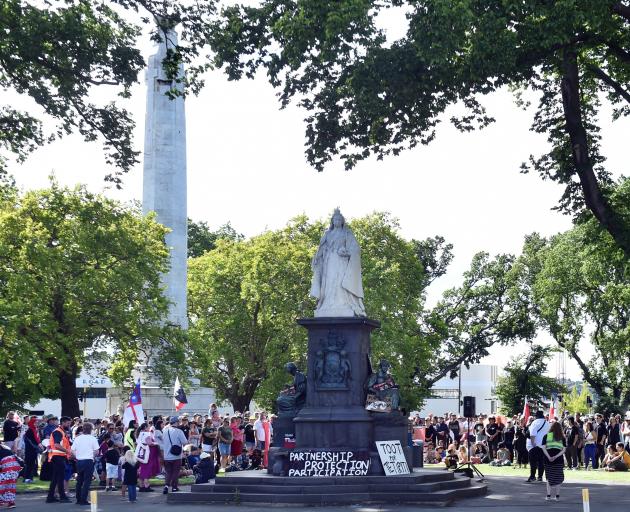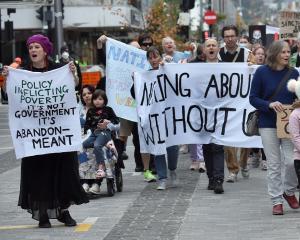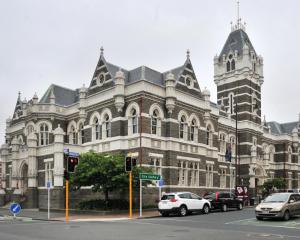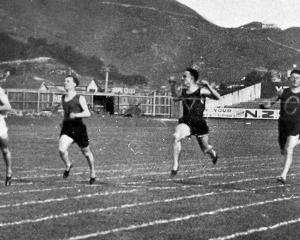
By the time the Te Papa protestors had finished their work in ‘‘our place’’ late last year, the redaction was all but complete.
What remained was this:
Article the first: ‘‘no’’.
Article the second: ‘‘Her Majesty the Queen of England the alie[n]’’.
Article the third: ‘‘ration the Queen’s veges’’.
The rest of the English draft of the Treaty of Waitangi was blacked and obscured by the rappelling activists.
Not much to go on, and indeed it’s not clear who precisely would be principally impacted by the vegetable rationing, the Queen or those who normally have access to her produce.
Of course, the dietary advice was just for fun. The group’s serious message was that the wall-sized English text, the only one most Te Papa visitors would be able to read, was misleading. It was not an accurate translation of Te Tiriti o Waitangi, the te reo Māori text that most rangatira signed. Given that, it is dollars to doughnuts that given half a chance they’d swiftly apply their redacting black paint to what David Seymour’s Act Party is, apparently, proposing.
According to a leaked document from the Ministry of Justice, Act wants to swap out Te Tiriti for this:
1. Kawanatanga katoa o o ratou whenua: the New Zealand government has the right to govern all New Zealanders.
2. Ki nga tangata katoa o Nu Tireni te tino rangatiratanga o o ratou whenua o ratou kainga me o ratou taonga katoa: the New Zealand government will honour all New Zealanders in the chieftainship of their land and property.
3. A ratou nga tikanga katoa rite tahi: all New Zealanders are equal under the law with the same rights and duties.
The response has been swift and clear at Ngāruawāhia and Rātana Pā, with Waitangi to come, that Act is trying to erase Māori from Te Tiriti o Waitangi.
Compare the Act Party’s second article, which talks only about ‘‘nga tangata katoa’’(all the people), to Te Tiriti’s ‘‘ki nga Rangatira ki nga hapu - ki nga tangata katoa’’. You’ll notice that the rāngatira and hapū have gone missing.
Prof Sir Hugh Kawharu’s definitive translation of ‘‘te tuarua’’, the second article, says ‘‘The Queen of England agrees to protect the chiefs, the subtribes and all the people of New Zealand in the unqualified exercise of their chieftainship over their lands, villages and all their treasures’’.
So, Act is talking about a fundamental re-write, and not just of the second article.
Even if the Act Party’s Treaty principles Bill makes it no further than a select committee, it looks like we’re set for a thorough-going ding-dong debate about the Treaty, its meaning and its role.
We should prep.
Dr Paerau Warbrick is a senior lecturer in the University of Otago’s Te Tumu: School of Māori, Pacific and Indigenous Studies and a barrister with more than 20 years of experience. He’s taught a paper on Te Tiriti o Waitangi for the past 20 years and another on the Waitangi Tribunal.
We’ll ask him.
First up, he says, it is useful to understand that people commonly come at the Treaty from three different angles; the Treaty documents themselves, the principles based on the Treaty and the concept of a treaty. It is important not to confuse the three - so David Seymour and the Act Party might have tripped at the first hurdle.
‘‘I have always maintained for Treaty of Waitangi issues, you have to look at it in three ways,’’ Dr Warbrick says.
And first up is the Treaty itself, the texts.
‘‘Immediately, you have two texts, one in te reo Māori and one in English.’’
There are nine surviving copies of the Treaty and while the overwhelming majority of signatures were applied to the te reo Māori version negotiated at Waitangi, an English version was taken to Manukau and the Waikato.
But the two don’t reconcile, Dr Warbrick says, they use different concepts.
We’ve been aware of that, he says, since at least Ruth Ross’ 1972 article in the New Zealand Journal of History, ‘‘Te Tiriti o Waitangi: Texts and Translations’’.
Among other things, it insisted that the text in Māori was the authoritative version, influencing the work of historians and academics from Sir Keith Sinclair, to Prof Ranginui Walker and Dame Claudia Orange.
Still, it also drew attention back to the fact of the two versions, Warbrick says, sparking debate on their meaning anew, including on the difference between ‘‘kawanatanga’’ and ‘‘te tino rangtiratanga’’, governorship and sovereignty.
Another thing to keep in mind when thinking about the texts is that while the ink on parchment is important, low levels of literacy among Māori in 1840 meant many relied on the oral explanations of te reo Māori-speaking missionaries, Henry Williams and his ilk.
‘‘This is part of the story of the texts,’’ Dr Warbrick says.
‘‘The missionaries, part of that story was, they turned around and said to the rangatira, the chiefs, ‘look, it’s going to be good for you, there are Pākehā here already and the government, that’s going to look after the Pākehā people. You can have your lands and you just carry on, not a problem’.
‘‘That’s part of that story, that’s part of the texts. That’s one way of looking at it,’’ Dr Warbrick says.
The second way of looking at the issue is to focus on the ‘‘principles’’ of the Treaty of Waitangi.
‘‘Where did these principles come from?’’ he asks.
‘‘It comes from the Waitangi Tribunal.’’

The ’70s were a period of heightened activism around the Treaty. Ross’ article was an example of that, arguing that Māori did not surrender sovereignty, ceding only governorship to the Crown.
Māori said ‘‘see, we told you we never gave up these things’’, Dr Warbrick says.
By mid decade, the Rowling Labour government was passing the Treaty of Waitangi Act 1975, setting up the Waitangi Tribunal.
‘‘It gave powers to the tribunal to look at breaches of the Treaty, but in the actual wording of the statute they referred to ‘acts or omissions inconsistent with the principles of the Treaty of Waitangi’.’’
That is the source of the phrase ‘‘principles of the Treaty of Waitangi’’, he says.
Tribunal members did look to the original text, and considered arguments such as the contra proferentem rule, also known as ‘‘interpretation against the draftsman’’. It means if the French offer a treaty to the Germans and it is in French, then the Germans’ understanding of the text is the deciding one.
But the tribunal soon moved on to looking at the spirit and principles of the Treaty, Warbrick says.
‘‘What exactly was envisaged here?’’
Fast forward a few years, he says, and in the midst of Roger Douglas’ headlong rush to privatise the country, Māori began to raise objections. If disputed ancestral land was sold, what would happen to their claims before the tribunal?
So, in the late ’80s Graham Latimer and the New Zealand Māori Council took the government to court to challenge land transfers to the new state-owned enterprises.
The case, known as the Lands Case, went to the Court of Appeal, where the assembled justices were immediately faced with the question of what the principles of the Treaty meant - and dispatched their clerks to get them some reading matter.
A couple of those justices later told the story at a conference at the University of Otago, Dr Warbrick says.
The clerks returned with the required reading.
‘‘And it was about half a metre high.’’
Among the papers were Claudia Orange’s recently published thesis - which became the best-selling book The Treaty of Waitangi - and Ruth Ross’ article, and much else.
The justices read it all and found for Māori and in doing so crafted some wording around the principles.
‘‘There are some big principles that came out of that case and it is really the granddaddy of all the principles.
A couple of the big ones were that the Crown has to act reasonably and in good faith towards Māori - from where we get the need to consult - and that the Crown has a duty of active protection towards Māori.
Māori concerns had to be specifically considered with respect to government actions, and actions needed to follow.
So, the principles are the work of the courts and the tribunal, the necessary response to the government’s use of the wording in the Treaty of Waitangi Act.
The third way to look at the Treaty is the ‘‘concept’’ of the Treaty, Dr Warbrick says.
‘‘The Treaty as a cultural phenomenon.’’
There are all sorts of views here, he says. Seymour seems to be seeing it as simply equal citizenship.
‘‘That’s a conceptual view, that doesn’t have a grounding in the text, it doesn’t have a grounding in the principles.’’
Many Māori also hold a conceptual view of the treaty.
Theirs tends to be that the Treaty allowed Pākehā to come to New Zealand, and provided a way for that to happen peacefully and harmoniously - that it didn’t play out that way meant the treaty had been breached and led to grievances.
‘‘So, they understand these big concepts like that.’’
Conceptual understandings among the wider Pākehā population range from an acceptance that the Treaty granted the right to Pākehā to come here, through to a belief that it’s divisive and dangerous and we need to get rid of it.
So, that’s the Treaty; the texts, the principles and the concepts.
‘‘When people start talking about the Treaty you have to try to understand, are you talking about the text, are you talking about the principles, or are you going back and forth between the two?’’
On the face of it, Act’s Bill addresses the ‘‘principles of the Treaty of Waitangi’’, the phrase coined in the 1975 Act.
But based on Dr Warbrick’s exposition, the focus of Act’s Bill is elsewhere.
While their Bill talks about principles, according to the leaked Ministry of Justice document, their three-clause wording seems to address the texts of the Treaty.
Yet, Act’s second and third ‘‘principles’’ are it’s own conceptualisations, they have no basis in the texts of the Treaty nor the accepted principles, Dr Warbrick says.
They are cherry-picking, as politicians are want to do and in doing so, they’re eliding some inconvenient facts about the Treaty. For example, that in some areas the meaning of the original texts is really very clear and beyond much debate.
‘‘When you actually look at the texts and you start to really read provisions that aren’t in conflict, it is actually quite straightforward,’’ Dr Warbrick says.
‘‘Māori were guaranteed to keep their lands, forests, fisheries and other properties.
‘‘And also in the texts, Māori got all the rights, the same rights of British subjects.’’
Article three is a perfect translation, the English and te reo Māori texts, one to the other, he says.
‘‘It didn’t say that Māori were British subjects, it said they got all the rights that [the British] have.’’
Whatever form the Act Party’s Bill finally takes, it will have to contend with all of this, the fact that behind those well-established principles, dating back to the Lands Case, sit nine original copies of the text.
‘‘Even if you could abolish the principles of the Treaty of Waitangi ... well, that’s not getting rid of the text, is it? So, we go back to the text,’’ Dr Warbrick says.
Early New Zealand governments tried to bury the text, but failed, so a 21st century attempt is unlikely to be any more successful.
‘‘What are you going to try to do, legislate against the concept of the Treaty of Waitangi? Good luck with that, because you can’t. It is in people’s hearts and minds, you can’t legislate against that.
‘‘That’s like turning around and saying ‘what we are going to do is abolish the concept of fairness’.’’
Te Tiriti
From Prof Sir Hugh Kawharu’s translation of the te reo Māori version of the Treaty:
The first
The Chiefs of the Confederation and all the Chiefs who have not joined that Confederation give absolutely to the Queen of England for ever the complete government over their land.
The second
The Queen of England agrees to protect the chiefs, the subtribes and all the people of New Zealand in the unqualified exercise of their chieftainship over their lands, villages and all their treasures.
The third
For this agreed arrangement therefore concerning the Government of the Queen, the Queen of England will protect all the ordinary people of New Zealand and will give them the same rights and duties of citizenship as the people of England.
Source: Waitangi Tribunal












